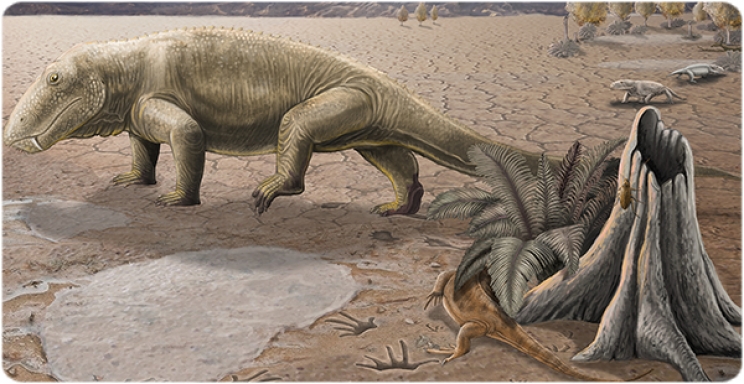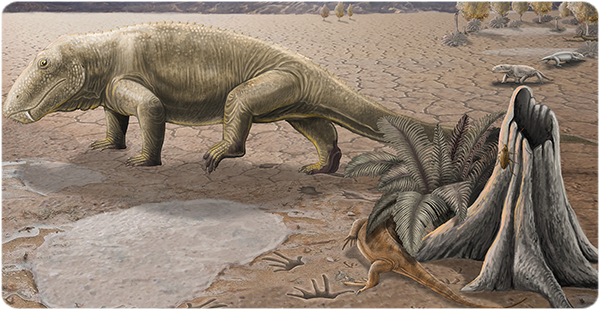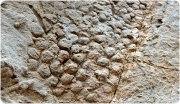Around 252 million years ago, during the transition from the Permian to the Triassic period, there was a period of roughly one million years marked by massive volcanic eruptions that released large amounts of carbon dioxide into the atmosphere. This event had a severe impact on the global climate, leading to various atmospheric imbalances culminating in an event known as "the Great Dying", the most massive and devastating extinction event in Earth's history. The cataclysm caused the vanishing of approximately 90% of all species inhabiting the planet due to a poor oxygen atmosphere and ocean acidification. Many vertebrate groups did not survive this cataclysm, and today, we only know of their existance through the fossil record.
Now, a research team from the Institut Català de Paleontologia Miquel Crusafont (ICP) has studied two epochs prior to that devastating extinction: the Cisuralian (or Early Permian), which began around 298 million years ago, and the Guadalupian (or Middle Permian), which started around 273 million years ago. Researchers from the Computational Paleobiology research group at the ICP have described a shift in the faunas that occurred during the transition between these two epochs due to environmental changes. The study relies on the fossil record from three sites around the town Castellar de n'Hug (in the Catalan Pyrenees), combining stratigraphic and sedimentological analysis to understand the rock deposition and paleontological analysis to identify the organisms that inhabited this area.
The study concludes that during the Cisuralian period, the Berguedà area had a landscape characterized by extensive meandering rivers and floodplains alongside volcanic activity. Following this, in the Guadalupian period, the climate shifted towards increased aridity, resembling the current conditions found in Death Valley, California, for a significant portion of the year. Within this desert setting, dry lakes exhibiting desiccation cracks were prevalent, periodically flooded by monsoonal rains. These intermittent water sources facilitated the resurgence of diverse life forms, including various groups of tetrapods (four-legged animals) that left their imprint in the fossil record.

Image 1: The tetrapod ichnoassociation depicts the evolution from fluvial environments (left) to dry lake systems (right).
Although the Permian tetrapod bones around Pangea's equator are scarce in the fossil record, there is a significant presence of ichnites (fossil footprints), enabling the study of vertebrate communities from that era. "During the Cisuralian period, characterized by a fluvial environment and active volcanism, we identified the presence of amphibians that left behind footprints known as Batrachichnus, resembling those made by a small salamander," commented Chabier De Jaime, a predoctoral researcher at ICP and the first author of the article. "Additionally, we discovered traces of amniotes, reptiles that left distinct footprints in the Permian record, such as Hyloidichnus and Dromopus, and parareptiles identified by the icnite species Pachypes. Furthermore, we encountered another tetrapod footprint that remains undetermined," De Jaime further explained.
Conversely, in footprints linked to the Guadalupian epoch characterized by a dry environment with intermittent monsoonal rains, therapsids (an order of synapsids believed to be the ancestors of mammals) emerged. The research team has identified the presence of footprints known as Brontopus, believed to be created by large therapsids that would have played a carnivorous role in this ecosystem. Such footprints are relatively rare within the fossil record.
"These carnivores lived alongside captorhinids, lizard-like reptiles capable of reaching lengths up to one meter, representing the earliest known herbivorous fauna. They likely subsisted on a diet of conifers, horsetails, and ferns", elaborates Josep Fortuny, head of the Computational Paleobiology research group at ICP. "While less prevalent, we also encountered evidence of parareptiles. However, it's striking that in this exceedingly arid climate, there's a notable absence of recorded amphibian presence", Fortuny further highlights.
To analize the footprints, the team utilized the photogrammetry technique. This method involved taking photographs encompassing the fossil from a 360° perspective, enabling the creation of a 3D model. This approach facilitated the analysis of the locomotion patterns of animals, including those responsible for creating the Brontopus morphotype footprints.
In addition to De Jaime and Fortuny, the research team comprised Eudald Mujal (ICP and Staatliches Museum für Naturkunde Stuttgart), Oriol Oms (Universitat Autònoma de Barcelona), Arnau Bolet (ICP, Universidad de Granada, and University of Bristol), Jaume Dinarès-Turell (Istituto Nazionale di Geofisica e Vulcanologia), and Jordi Ibáñez-Insa (GEO3BCN-CSIC). They firmly believe that Berguedà still harbors untapped potential, promising many more new fossils that could significantly contribute to furthering our understanding of the Permian period in the Catalan Pyrenees.
Main Image: Guadalupian paleoenvironment reconstruction in Berguedà (Catalonia, NE Spain) and related fauna: on the left, the Brontopus trackmaker, partially obscured on the right, the Dromopus trackmaker, and in the far right background, two trackmakers of Hyloidichnus. Roc Olivé / © Institut Català de Paleontologia Miquel Crusafont. With the collaboration of Fundación Española para la Ciencia y la Tecnología – Ministerio de Economía, Industria y Competitividad.
Research article:
- De Jaime-Soguero, C., Mujal, E., Oms, O., Bolet, A., Dinarès-Turell, J., Ibáñez-Insa, J., & Fortuny, J. (2023). Palaeoenvironmental reconstruction of a lower to middle Permian terrestrial composite succession from the Catalan Pyrenees: implications for the evolution of tetrapod ecosystems in equatorial Pangaea. Palaeogeography, Palaeoclimatology, Palaeoecology, 632, 111837. https://doi.org/10.1016/j.palaeo.2023.111837















